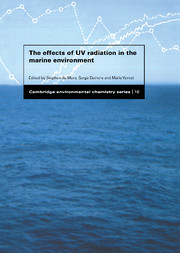Book contents
- Frontmatter
- Contents
- Contributors
- Preface
- 1 Enhanced UV radiation – a new problem for the marine environment
- 2 UV physics and optics
- 3 Spectral weighting functions for quantifying effects of UV radiation in marine ecosystems
- 4 Marine photochemistry and its impact on carbon cycling
- 5 Photochemical production of biological substrates
- 6 Mechanisms of UV damage to aquatic organisms
- 7 Strategies for the minimisation of UV-induced damage
- 8 UV radiation effects on heterotrophic bacterioplankton and viruses in marine ecosystems
- 9 Effects of UV radiation on the physiology and ecology of marine phytoplankton
- 10 Impact of solar UV radiation on zooplankton and fish
- 11 Implications of UV radiation for the food web structure and consequences on the carbon flow
- Index
6 - Mechanisms of UV damage to aquatic organisms
Published online by Cambridge University Press: 20 August 2009
- Frontmatter
- Contents
- Contributors
- Preface
- 1 Enhanced UV radiation – a new problem for the marine environment
- 2 UV physics and optics
- 3 Spectral weighting functions for quantifying effects of UV radiation in marine ecosystems
- 4 Marine photochemistry and its impact on carbon cycling
- 5 Photochemical production of biological substrates
- 6 Mechanisms of UV damage to aquatic organisms
- 7 Strategies for the minimisation of UV-induced damage
- 8 UV radiation effects on heterotrophic bacterioplankton and viruses in marine ecosystems
- 9 Effects of UV radiation on the physiology and ecology of marine phytoplankton
- 10 Impact of solar UV radiation on zooplankton and fish
- 11 Implications of UV radiation for the food web structure and consequences on the carbon flow
- Index
Summary
Introduction
UV radiation is the photochemically most reactive waveband of the incident solar radiation field and causes a broad spectrum of genetic and cytotoxic effects in aquatic organisms. In the natural environment, these responses are offset by various protection strategies such as avoidance, screening, photochemical quenching and repair. The net stress imposed by UV exposure thus reflects a balance between damage, repair and the energetic costs of protection, and may be manifested in terms of increased energy demand, changes in cell composition, and decreased growth and survival rates (Figure 6.1). In this chapter, we focus on the damaging effects of UV exposure, while Chapter 7 examines the protection mechanisms that allow organisms to avoid, reduce or recover from such effects.
At the cellular level the toxic effects of UV radiation are initiated by one of two photochemical pathways (Figure 6.1). Firstly, certain biomolecules such as proteins and nucleic acids have chromophores that absorb in the UV region of the spectrum. Under high UV fluxes these molecules are photochemically degraded or transformed, resulting in impairment or even complete loss of biological function. The magnitude of damage caused by these so-called direct or primary mechanisms is determined by the amount of radiation absorbed (optical cross-section in the UV range) and the quantum yield of photodestruction (molecules damaged per photon absorbed). A second class of UV toxicity effects is caused by a series of indirect mechanisms. UV is absorbed by some intermediate compound (photosensitising agent) either inside or outside the cell to produce reactive oxygen species (ROS).
- Type
- Chapter
- Information
- The Effects of UV Radiation in the Marine Environment , pp. 149 - 176Publisher: Cambridge University PressPrint publication year: 2000
- 112
- Cited by



